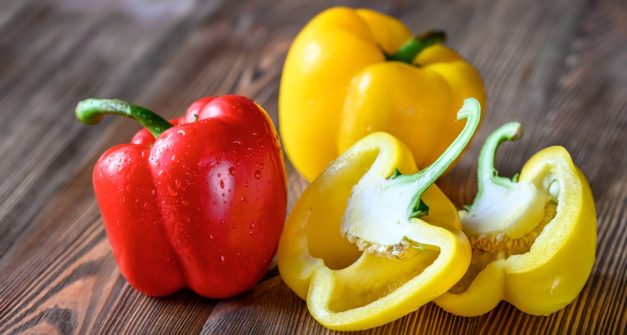Let’s discover the Bell Pepper, cultivation and growth, beneficial properties, and its nutrient potential as an anti-cancer agent for human health.
A wonderful combination of spicy taste and crunchy texture, the sweet bell pepper is the Christmas ornament of the vegetable world with its sinuous shape and shiny skin, available in a wide range of vibrant colors including green, red, yellow, orange, purple, and brown-black.
Despite their varied palette, they all belong to the same family, scientifically known as Capsicum annuum.
Bell peppers are plump bell-shaped vegetables consisting of three or four lobes. Green and purple bell peppers have a slightly bitter taste, while red, orange, and yellow ones are sweeter and almost fruity.
This variety of peppers is not ‘spicy,’ as the famous capsaicin is found in minimal quantities. Although peppers are available year-round, they are more abundant and flavorful during the summer months and early autumn.
Bell peppers are herbaceous or semi-woody plants, ranging from 30 cm to 2 m in height, with white or rarely purple flowers.
The fruit is a berry, with numerous seeds, highly variable in shape, size, and coloration, featuring the characteristic pungent flavor, sometimes very spicy.
It is mainly cultivated in southern regions. Bell peppers are distinguished into sweet varieties, with square or more or less rounded fruits, and spicy varieties, with elongated and conical fruits.
Bell peppers are consumed fresh or preserved in brine or vinegar.
The spicy ones are used as a condiment and for sauce production, or dried and powdered for paprika production. Some varieties (Chinese peppers) are also cultivated for ornamental purposes, due to their small and variably colored fruits. The garden forms are known as peperette or pepperoncini.
Cultivation of bell peppers
Bell peppers require fresh, loose soil, exposed to sunlight, and fertilized with manure and organic powdered fertilizer. The sowing is done in February on a warm bed to have a very early harvest, or in May in an open-air seedbed for a normal harvest.
The seedlings born from seeds in the seedbed are transplanted in April, when they have produced at least 5 leaves; planting is done in rows with a distance of 40 cm between each plant.
Plant growth
Immediately after planting, it is advisable to water abundantly; subsequently, this operation should be repeated, especially while the fruits are enlarging and ripening; it is essential to keep the soil well-hoed, loose, and free from weeds; if the plants are heavily loaded with fruits, it is advisable to provide them with supports.
Harvesting can begin after two months from transplanting for early varieties, while for late ones, it is necessary to wait 3-4 months.
The antioxidant benefits of bell peppers
While research studies have tended to focus on carotenoids as characteristic antioxidants in bell peppers, this vegetable actually offers a much broader range of antioxidants.
Antioxidants and vitamin C in this vegetable
Within this list of antioxidant phytonutrients, it is understandable why carotenoids have been singled out for research attention.
Among the five carotenoids listed above, bell peppers contain concentrated amounts of beta-carotene and zeaxanthin (a yellow-orange natural coloring substance).
- Flavonoids
- Luteolin
- Quercetin
- Hesperidin
- Carotenoids
- Alpha-carotene
- Beta-carotene
- Cryptoxanthin
- Lutein
- Zeaxanthin
- Hydroxycinnamic Acids
- Ferulic acid
- Cinnamic acid
A “cup” of fresh sliced bell pepper, for example, contains about 1,500 micrograms of beta-carotene, or the same as about one-third of a small carrot.
In terms of conventional nutrients, bell pepper is an excellent source of vitamin C and vitamin E. In addition to these traditional antioxidant vitamins, the list of phytonutrients in bell pepper is impressive, and you can see the main nutrients listed next to it.
In a recent study, Spanish researchers took a very detailed look at vitamin C, vitamin E, and six different carotenoids (alpha-carotene, beta-carotene, lycopene, lutein, zeaxanthin, and cryptoxanthin) in all commonly consumed foods.
Only two vegetables were determined to contain at least two-thirds of these nutrients. One of these foods was tomato, and the other was sweet bell pepper. Furthermore, bell pepper alone was instrumental in providing 12% of total zeaxanthin intake and 7% of total vitamin C intake.
This outstanding balance identifies sweet bell pepper as an antioxidant-rich food.
Nutritional Values of bell pepper
- Energy: 19
- Energy: 81
- Fat: 0.2
- Carbohydrates: 2.9
- Dietary fiber: 3.6
- Protein: 1.1
We look forward to seeing the antioxidant benefits of sweet bell pepper demonstrated in human health, including studies on the prevention of cardiovascular diseases and type 2 diabetes, as well as the antioxidant benefits in the field of eye health.
These two particular carotenoids are present in high concentrations in the macula of the eye (the central part of the retina) and are held responsible for protecting the macula from oxygen-related damage. In a condition called age-related macular degeneration, or AMD, the macula of the eye can become damaged, and vision can be lost.
(In the United States, AMD is the leading cause of blindness in adults over the age of 60), and we suspect that future human studies will show a reduced risk of AMD with regular consumption of bell peppers due to their strong antioxidant benefits (and specifically, their unique concentration of lutein and zeaxanthin).
Did you know that bell pepper is a powerful anti-cancer food?
As a nutrient-rich food with antioxidant and anti-inflammatory properties, we would expect bell peppers to provide important anti-cancer benefits.
Exposure to excessive chronic inflammation and unwanted chronic oxidative stress can increase the risk of developing cancer for most types of cancer, and both of these factors can be partially offset by diet.
(Regular intake of antioxidant nutrients can reduce the risk of chronic oxidative stress, and regular intake of anti-inflammatory nutrients can lower the risk of excessive chronic inflammation.)
With a rich supply of phytonutrients that have antioxidant and anti-inflammatory properties, we would expect bell peppers to make a significant contribution to offsetting these factors and reducing our risk of developing cancer.

